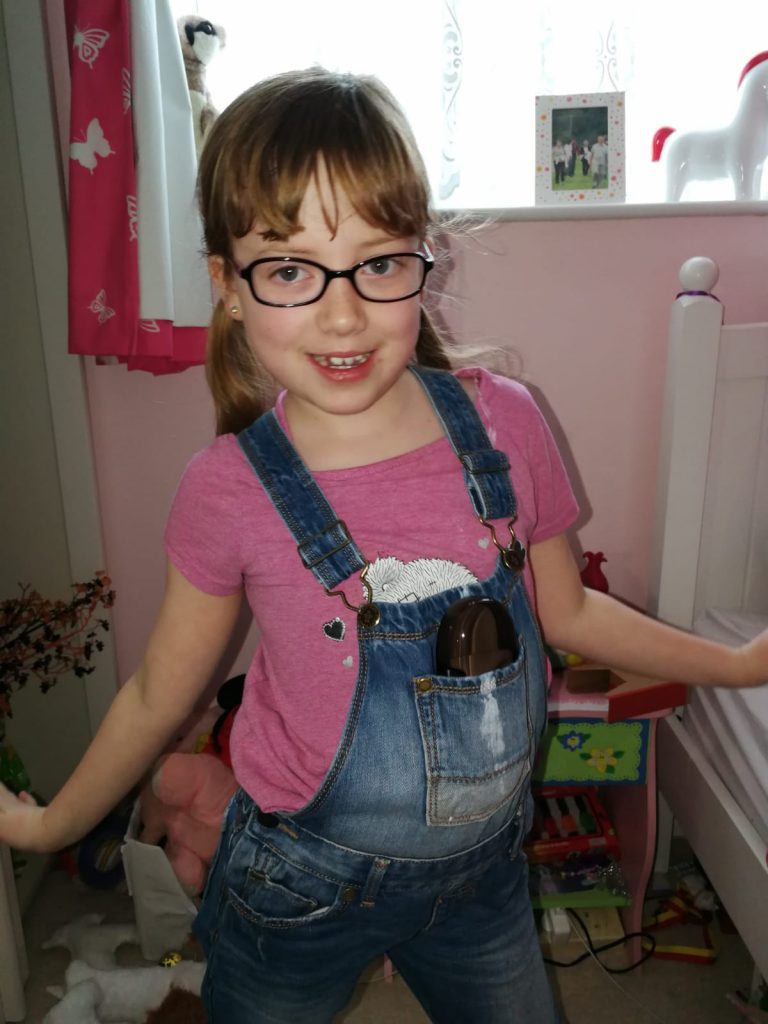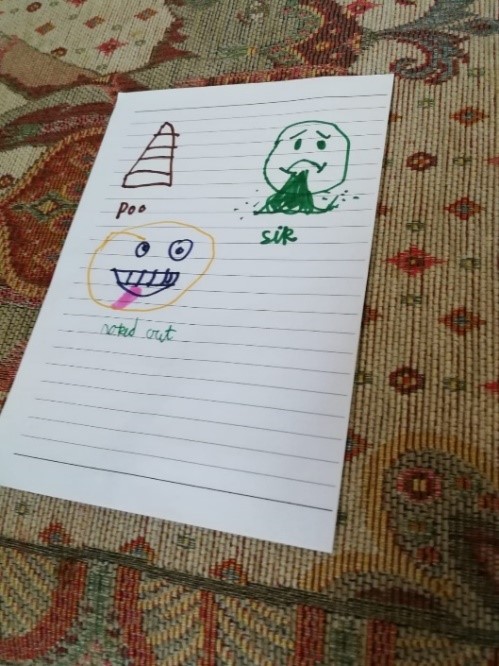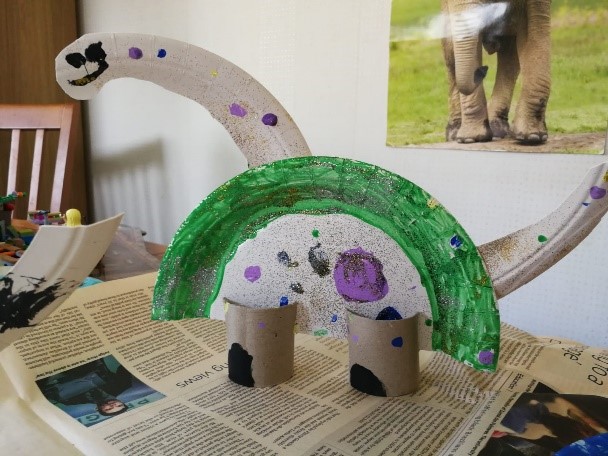Hi… I’m Steven from the Library and Learning Resources Team. If you told me two months ago I’d be working from home whilst simultaneously home schooling my two children Samantha (8) and Jack (3), I would have laughed…
…well am I still laughing?
To say it’s been a learning curve would be an understatement. Children are needy, distracting and completely wonderful. An irresistible blend not conducive to work. I wanted to share some of my experiences of working from home and hope that some of the resources we’ve discovered might be a help to you…

Samantha 
Jack
Finding a new routine
I started with the noble ambition that my work would be wholly unaffected… a noble ambition which was starting to take its toll by day 3. By the Thursday of week one I was mentally in a bad place. Finding a new working pattern has been vital not just for me, but for us as a family. I now start work much earlier at around 7am, my son will have woken up before 6 anyway and I’ve always been one of those horrible morning people.
The afternoons I concentrate on my children and give them dedicated care and attention they need and try to set work completely to one side. Finding a routine that will work for you may not be easy to find but try new things and see what works. It’s important to share your routine with colleagues, so others know when it is a good time to contact you. I’ve been using Outlook Out of Office and availability within Microsoft Teams to try and let people know when I’m free.
Staying in touch with the school
We’ve found it vital to stay in close contact with Samantha’s school. We’ve been regularly emailing Samantha’s teacher to get feedback on the work she’s been doing. Her hand writing has improved enough that her teacher awarded her “pen licence” over email. The feedback isn’t just great for Samantha to stay motivated and keep connected to the school but it’s given us the peace of mind that she is still progressing as she should. Samantha’s school has been running sing along assemblies via YouTube. Keep an eye on what your school is offering.
Supplementary educational resources
If you’re looking for some supplementary educational resources to add to what your school is providing for home school, there are a wealth of resources available online. You’ll also find some great resources made available by CCCU here https://blogs.canterbury.ac.uk/studentnews/cccu-resources-to-support-parent-students/. We’ve only dipped into little bits but here are some things that have caught our eye:
- STEM@Home
- BBC Bitesize and read the parents toolkit on supporting your child too
- Chatterpack learning
- Kent Children’s University
- Teachwire free resources
- Live Science
- Mathematics Mastery
- WowScience
- YouTube free school
The importance of play for young children shouldn’t be underestimated. Read Don’t turn your home into school … the Lego professor of play on lockdown learning available on the Guardian website.
Girl Guiding / Scouts
Samantha is a Brownie and the Brownie’s have been amazing at sending us fun activities to do. Your child doesn’t have to be a member of one of the organizations to take advantage. Check out the Scouts “The Great Indoors” or the Girl Guiding “Adventures at home” for some wonderful activity suggestions, mixed with helpful advice about children’s mental health. We asked Samantha to draw the emojis she knew for one activity and this is what we got…

…poo, sick and knocked out. I’m really getting to know my daughter!
But seriously it’s been helpful to still be working on her badges. It’s given her goals she’s wanted to achieve and the badges are usually interesting or fun to work on.
Public Library
There’s no surprise that the public library has become a big part of our children’s lives. Your local public library twitter feed will be a great one to follow. Kent Libraries have a range of children’s e-books and audiobooks. The access to ebooks and audiobooks has meant the children have remained engaged with the public library even when we can’t visit the buildings themselves.
My colleague Gaelle has also been making use of the public library too
“We have loved our public library’s audiobooks collection. Kent Libraries have classics like Harry Potter read by Stephen Fry among others, and they also take recommendations for new titles if you can’t find what you would like. Furthermore, they were quick to email us that our recommendations had become available!”
Gaelle Laprunge – Library and Information Advisor
Audiobooks
My daughter has always been travel sick and listening to audiobooks in the car, has been one of the few things that have helped make journeys puke free. She’s now listening to audiobooks in the house instead and it’s been great that there have been so many free audiobook options available:
- Audible stories has been brilliant. It’s been a joy watching her get a kick out of Scarlett Johansson’s reading of Alice in Wonderland. One of my favourite books.
- David Walliams has been releasing weekly audiobooks.
- For something even more out of this world take a look at story time from space.
Books
Samantha and I are currently half way through book 7 of the Chronicles of Narnia. We’ll soon be done and it’s sometimes hard to know what to read next.
- I particularly like these National Geographic recommendations of family books from around the world.
- The Conversation has put together some titles that function both as mirrors and windows for children as the world faces the effects of Coronavirus.
- The Centre for Literacy and Primary Education (CLPE) have made their 2018 World Book Day resources available again.
Screen time
Screen time can be a useful tool to get a much-needed break to fit in some work but can also leave you feeling a bit guilty. Screen time is often demonised by the media but during these times we’ve certainly been using it as an opportunity to keep up. Screen time can also be educational. The Guardian has a run down of some of the best educational apps and Samantha has been doing a daily times tables app through the school. If your child is in to video games there’s an interesting article on CNN about making screen time quality family time. Teach.com also have useful tips on balancing children’s screen time.
We’ve also enjoyed working through some of the Into film guides. The guides act as informal discussion prompts for after viewing a film as well as other activities to work on. It uses Moana as a jumping point to discuss the women you look up to or uses Toy Story 4 to more closely consider Bonnie’s attachment to Forky. If you’re one of the many recent Disney+ subscribers, they have also provided similar materials to support their Disneynature documentaries. It’s been great to make film watching a less passive experience and got Sam thinking a bit deeper about a film’s main message.
Arts, Crafts and other activities

Our family of hand parrots 
Paper plate and loo roll dinosaur
Talking about attachment to things that have been made, Jack has been playing a lot with his dinosaur made out a paper plate and a loo roll. Not sure why we have all those plastic toys lying around now! We’ve made a family of parrots by drawing round our hands, rainbows for our windows and we currently have paper octopi in our hallway. In fact, at this point, we have craft just about everywhere. I personally find there’s something very therapeutic about drawing, colouring and sticking.
Some sites you might want to take a look at include
- Children’s illustrator, Rob Bidulph’s YouTube Channel where he’s passing on drawing tips.
- Mr Payne’s Easy art for kids YouTube Channel.
- For another beautiful free resource, Adobe have been putting together colouring books, created from contributions from leading artists and illustrators.
- For those with very little ones, this round up of activities for one year olds looks good – https://busytoddler.com/2018/02/activities-for-1-year-olds/
- New York Public Library has a range of at home activities to make and do https://www.nypl.org/blog/2020/04/24/recipes-at-home-play
Keep active
Joe Wicks really has really become the nation’s PE teacher, hasn’t he? I remember a time when my YouTube feed wasn’t just about exercise!
I’m not much of a runner though, so I’ve asked my colleague Gaelle to talk about her experience introducing jogging to her children
In the spirit of helping us with daily exercise, the World Athletics website and that of England Athletics have both added ‘at home’ sections with bite-size advice and fun videos especially designed for beginner runners and parents with no access to much space or equipment.
It might be surprisingly easy to introduce jogging to children and teens in these endless weeks at home by mashing a Couch-to-5K programme schedule and those confinement-specific Daily Mile tips.
The children we know liked the idea of improving their cardio-fitness and were quick to move beyond the stitches and out-of-breath stage (could it be humans were born to run?). We jog and walk every other day ‘directly from the front door’ – one of the tips from the Daily Mile website. This might or might not lead us to 5K but we think we feel better for it.
This accessible article from the World Athletics website explores our state of knowledge on the benefits of endurance exercise on our brain functions.
For “a collection of guidelines for safe distance running with elementary-age children” head to this informative article ( by Seth Jenny and Tess Armstrong in JOPERD: The Journal of Physical Education, Recreation & Dance Mar2013, Vol. 84 Issue 3, p17 9p.) available on Library Search.
They stress running should be done “at a comfortable, easy-to-moderate pace interspersed with walking if the child desires.”
Gaelle Laprunge, Library and Information Advisor
We’ve been getting most of our exercise in the garden. The sun has been shining and a lot of football has been played. Samantha is part of her school football club, so it’s been fun seeing just how good she’s got! We’ve also been learning the joy of plants, we have sweetcorn, runner beans, courgettes, tomatoes and strawberries growing and we’ve planted different varieties of sunflower too. I’ve always felt a connection to nature and greenspaces has huge benefits to wellbeing. Make use of the spaces you have, however big or small. If you don’t have an outdoor space you can always plant cress or different herbs for one of your window sills.

Find anything useful?
I’ve found reading the experiences of other parents really helpful. Becky’s blog is a wonderful read.
Let us know if you find any of the resources mentioned useful in the comments below. Also please send us links to some of the activities you’ve been occupying your children with. Good luck!
 Library
Library Steve Peters
Steve Peters 1027
1027


